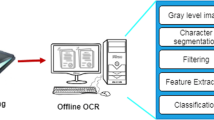Abstract
We present a method for character recognition especially designed for the case in which the shapes of characters belonging to the same class vary greatly, as it happens with unconstrained hand-printed characters and omnifont printed characters. The most distinctive feature of the method is the use of a special kind of structural description of character shape in connection with a neural network classifier. An original technique is used to achieve the best trade-off between reject and misclassification rates. Experimental results on databases of both hand-printed and printed characters are illustrated.
Similar content being viewed by others
References
Arcelli C, Sanniti di Baja G (1981) A thinning algorithm based on prominence detection. Patt Recogn 13: 225–235
Arcelli C, Cordelia LP, Levialdi S (1981) From local maxima to connected skeletons. IEEE Trans Patt Anal Machine Intell 3: 134–143
Boccignone G, Chianese A, Cordelia LP, Marcelli A (1990) Using skeletons for OCR. In: Cantoni V, Cordelia LP, Levialdi S, Sanniti di Baja G (eds) Image analysis and processing. World Scientific, Singapore, pp 275–282
Chianese A, Cordelia LP, De Santo M, Vento M (1989) Decomposition of ribbon-like shapes, Proceedings of the 6th Scandinavian Conference on Image Analysis, Oulu, Finland, pp. 416–423
Chianese A, Cordelia LP, De Santo M, De Stefano C, Vento M (1992) On the comparison among description methods by neural networks. In: Cantoni V, Ferretti M, Levialdi S, Negrini R, Stefanelli R (eds) Progress in image analysis and processing II. World Scientific, Singapore, pp 461–465
Cordella LP, De Stefano C, Tortorella F, Vento M (1993) Classification rules for supervised neural classifiers. Proceedings of the 8th Scandinavian Conference on Image Analysis, Tromso, Norway, pp 539–545
Chouinard C, Plamondon R (1992) Thinning and segmenting handwritten characters by line following. Machine Vision Appl 5: 185–197
Fukushima K (1988) Neocognitron: a hierarchical neural network capable of visual pattern recognition. Neural Networks 1: 119–130
Govindan VK, Shivaprasad AP (1990) Character recognition - a review. Patt Recogn 23: 671–683
Haralick RM, Shapiro LG (1981) Structural description and inexact matching. IEEE Trans Patt Anal Machine Intell 5: 504–519
Kahan S, Pavlidis T, Baird S (1987) On the recognition of printed characters of any font and size. IEEE Trans Patt Anal Machine Intell 9: 274–288
Kimura F, Shridar M (1992) Segmentation-recognition algorithm for zip code field recognition. Machine Vision Appl 5: 199–210
Kobayashi K, Yoda F, Yamamoto K, Nambu H (1983) Recognition of handprinted kanji characters by the stroke matching method. Patt Recogn Lett 1:481–488
Levine MD (1969) Feature extraction: a survey. Proc IEEE 57: 1351–1419
Liao CW, Huang JS (1990) Stroke segmentation by Bernstein-Bezier curve fitting. Patt Recogn 23: 475–484
Lippman RP (1987) An introduction to computing with neural nets. IEEE ASSP Magazine 4: 4–22
Mori S, Suen CY, Yamamoto K (1992) Historical review of OCR research and development. Proc IEEE 80: 1029–1058
Nagy G (1982) Optical character recognition: theory and practice. In: Kanal L and Krisnaiah PR (eds) Handbook of statistics II. North Holland, Amsterdam, pp 621–649
Pavlidis T, Ali F (1979) A hierarchical syntactic shape analyzer. IEEE Trans Part Anal Machine Intell 1: 2–9
Pavlidis T, Mori S (eds) (1992) Proc IEEE, Special Issue on Optical Character Recognition 80:1059–1194
Rummelhart DE, McClelland JL (1986) Parallel distributed processingexplorations in the microstructure of cognition, Vol 1: Foundations. MIT Press, Cambridge, Mass
Simpson PK (1990) Artificial neural systems. Pergamon Press, Elmsford, New York
Author information
Authors and Affiliations
Rights and permissions
About this article
Cite this article
Cordella, L.P., De Stefano, C. & Vento, M. A neural network classifier for OCR using structural descriptions. Machine Vis. Apps. 8, 336–342 (1995). https://doi.org/10.1007/BF01211495
Issue Date:
DOI: https://doi.org/10.1007/BF01211495




